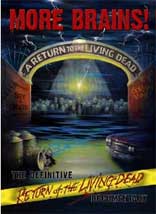 MORE
BRAINS! A RETURN TO THE LIVING DEAD (2011)
MORE
BRAINS! A RETURN TO THE LIVING DEAD (2011)Director: Bill Philputt
Michael Perez Entertainment
 MORE
BRAINS! A RETURN TO THE LIVING DEAD (2011)
MORE
BRAINS! A RETURN TO THE LIVING DEAD (2011)MORE BRAINS! A RETURN TO THE LIVING DEAD answers everything you always wanted to know about Dan O’Bannon’s 1985 cult classic that MGM didn’t bother to ask on their two special editions.
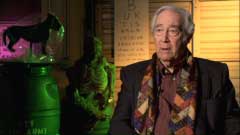
Narrated by Brian Peck (CHILDREN OF THE CORN III) – who plays Scuz in the film – MORE BRAINS! charts RETURN OF THE LIVING DEAD from conception to reception over the course of two hours with an impressive roster of surviving participants, including some for whom the project was definitely not an enjoyable experience. Comprised mainly of talking heads, some animation interludes, a sparing use of clips, and a perhaps even less workprint footage (despite its apparent availability in bootleg circles), everyone has something to say about the various aspects of the production (some of the blurbs seem less valuable, and more in the service of the flow of the editing), but here are some of the highlights: Clu Gulager (THE KILLERS) reveals that he was nervous about going over the top, especially when acting against Karen (Scott Brady and Leslie Nielsen were also considered for the role). Don Calfa (10) hints at the ways that learning that his character was named after a high-ranking Nazi influenced the way he crafted his character. James Karen (POLTERGEIST) reveals that his death scene was his suggestion, including a way to set it up earlier in the film (during a scene shot at a later point). Thom Mathews (JASON LIVES: FRIDAY THE 13TH PART VI) reveals that he pierced his ear for the part, not realizing that piercings could be faked (he also suggests that his character was likely the one with O’Bannon identified). Matthews and Karen also have plenty of fond memories of working with each other, since they shared the most screen time together.
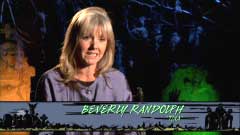 Beverly
Randolph relates her unnerving visit to O’Bannon’s home for an audition,
and the multiple takes he had her do falling into the mud (as well as the injuries
she sustained falling through the basement steps, which she did not get to rehearse).
Several cast and crew members have input into Linnea Quigley’s anecdote
about her cemetery striptease, producer Henderson’s reaction to the site
of the actress’ pubic hair, and the efforts of the effects men to rectify
the situation. Miguel A. Nunez Jr. (FRIDAY THE 13TH V: A NEW BEGINNING) reveals
that he was homeless before he got the role, and riffs on the film’s fashions
(and Quigley’s breasts). Jewel Shepherd (CHRISTINA) reveals that O’Bannon
originally wanted to cast her has Trash, but she wanted to play the party girl
instead (“I couldn’t be naked anymore!”). Linnea Quigley (NIGHT
OF THE DEMONS) replaced the actress originally cast to play Trash – previously
known as “Legs” in the script – and describes her trepidation
at doing her death scene, and wearing the extended mouth appliance for her zombie
incarnation. John Philbin (CHILDREN OF THE CORN) was not really satisfied with
his character and wardrobe, and wishes in retrospect that he had been more assertive.
Puppeteer Allan Trautman – aka Tarman – describes the ordeals of
having to wear the costume (which was comprised of melted vinyl drippings on
foil strips). Stand-in Drew Deighan was promoted to “Paramedic #1”
because the original actor was not working out (“Paramedic #2” James
Dalesandro is also interviewed). Mark Venturini (FRIDAY THE 13TH: A NEW BEGINNING
with Nunez) is fondly remembered by the cast and crew (the actor died of leukemia
in 1996).
Beverly
Randolph relates her unnerving visit to O’Bannon’s home for an audition,
and the multiple takes he had her do falling into the mud (as well as the injuries
she sustained falling through the basement steps, which she did not get to rehearse).
Several cast and crew members have input into Linnea Quigley’s anecdote
about her cemetery striptease, producer Henderson’s reaction to the site
of the actress’ pubic hair, and the efforts of the effects men to rectify
the situation. Miguel A. Nunez Jr. (FRIDAY THE 13TH V: A NEW BEGINNING) reveals
that he was homeless before he got the role, and riffs on the film’s fashions
(and Quigley’s breasts). Jewel Shepherd (CHRISTINA) reveals that O’Bannon
originally wanted to cast her has Trash, but she wanted to play the party girl
instead (“I couldn’t be naked anymore!”). Linnea Quigley (NIGHT
OF THE DEMONS) replaced the actress originally cast to play Trash – previously
known as “Legs” in the script – and describes her trepidation
at doing her death scene, and wearing the extended mouth appliance for her zombie
incarnation. John Philbin (CHILDREN OF THE CORN) was not really satisfied with
his character and wardrobe, and wishes in retrospect that he had been more assertive.
Puppeteer Allan Trautman – aka Tarman – describes the ordeals of
having to wear the costume (which was comprised of melted vinyl drippings on
foil strips). Stand-in Drew Deighan was promoted to “Paramedic #1”
because the original actor was not working out (“Paramedic #2” James
Dalesandro is also interviewed). Mark Venturini (FRIDAY THE 13TH: A NEW BEGINNING
with Nunez) is fondly remembered by the cast and crew (the actor died of leukemia
in 1996).
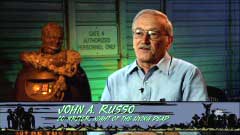
Paul Sammon – who was a marketing executive at Orion at the time – provides the contextual background about the split between George Romero and John Russo, and later the lack of faith the higher-ups at Orion had in the film’s potential box office success. Russo describes his original concept for RETURN OF THE LIVING DEAD – which he novelized in 1978 (the sequel was a long time in development, and Russo later wrote the novelization for the film in 1985). Producer Tom Fox (BLUE MONKEY) optioned the rights to the sequel, and eventually bought out Russo altogether. O’Bannon’s script varied greatly from the previous draft by NOTLD vets Rudy Ricci and Russ Streiner, and O’Bannon initially brought Tobe Hooper onto the project as director (the production stalled so many times, and Hooper was in England directing LIFEFORCE for Cannon when ROTLD was finally ready to commence filming). Sammon also provides some background on the remnants from a 1978 lawsuit regarding the Romero-Russo parting that cropped up as shooting was to begin. Casting director Stanzi Stokes – who had previously cast Quigley in SILENT NIGHT, DEADLY NIGHT and Calfa on 1942 – and Henderson describe the laborious casting process, which include mixing and matching various potential cast-mates to see how they jelled. She also reveals that Gulager was the last actor cast, despite being at the top of the list for the Burt character.
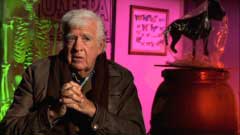 Director
of photography Jules Brenner (SALEM’S LOT) cites O’Bannon’s
strong visual influence from the EC Comics as having helped him realize the
film’s intended look. Production designer William Stout (PAN’S LABYRINTH)
also mentions the influence of the mummies of Guanajauto on his zombie designs
(he also mentions that he cameos as a bum towards the beginning of the film,
not the shopping cart one that gets attacked by a transformed Trash). Effects
artist Tony Gardener (DARKMAN) relates his first intimidating encounter with
Hemdale producer Graham Henderson (PLATOON), as well as the challenges of creating
the half-corpse. We also learn that Peck did the on-set voice of the female
half-corpse (later dubbed by someone else) and played the first zombie that
claws its way out of the dirt. When make-up effects artist William Munns (SUPERSTITION)
bid the film, he had been told that the actors would all be real punks, only
to be told different after signing onto the project. While the punk hairstyles
were created by a Los Angeles hairdresser with a reputation for the style, Munns
had to maintain the hairstyles from day to day. Second assistant editor John
Penney (THE KINDRED) appears briefly, but is featured more in the supplements
since he wrote RETURN OF THE LIVING DEAD 3. The documentary also goes into some
awkward areas such as the firing of effects artist Munns whose effects work
– other than Tarman – was apparently not up to snuff (fellow effects
artist Kenny Myers [SILENT MADNESS] is more tactful, while Stout does not hold
back in his criticism). There’s a bit of back and forth between the talking
heads of Shepard and Peck – who did not get along on set – which
also suggests that Peck was not the interviewer for all of the sessions (he
is sometimes heard off-camera and pops into frame during a blooper from the
Gulager interview). There are some conflicting stories about a blow-up between
Gulager and O’Bannon, and it is sometimes difficult to tell if some of
the actors are kidding or not (Gulager asserts his professionalism). There are
several different perspectives on O’Bannon’s treatment and direction
of actors (which sounds more puppeteer-like than collaborative) and memories
of mostly hands-off producer Tom Fox (who died in 2004, although he is credited
as executive producer on both ROTLD parts 4 and 5).
Director
of photography Jules Brenner (SALEM’S LOT) cites O’Bannon’s
strong visual influence from the EC Comics as having helped him realize the
film’s intended look. Production designer William Stout (PAN’S LABYRINTH)
also mentions the influence of the mummies of Guanajauto on his zombie designs
(he also mentions that he cameos as a bum towards the beginning of the film,
not the shopping cart one that gets attacked by a transformed Trash). Effects
artist Tony Gardener (DARKMAN) relates his first intimidating encounter with
Hemdale producer Graham Henderson (PLATOON), as well as the challenges of creating
the half-corpse. We also learn that Peck did the on-set voice of the female
half-corpse (later dubbed by someone else) and played the first zombie that
claws its way out of the dirt. When make-up effects artist William Munns (SUPERSTITION)
bid the film, he had been told that the actors would all be real punks, only
to be told different after signing onto the project. While the punk hairstyles
were created by a Los Angeles hairdresser with a reputation for the style, Munns
had to maintain the hairstyles from day to day. Second assistant editor John
Penney (THE KINDRED) appears briefly, but is featured more in the supplements
since he wrote RETURN OF THE LIVING DEAD 3. The documentary also goes into some
awkward areas such as the firing of effects artist Munns whose effects work
– other than Tarman – was apparently not up to snuff (fellow effects
artist Kenny Myers [SILENT MADNESS] is more tactful, while Stout does not hold
back in his criticism). There’s a bit of back and forth between the talking
heads of Shepard and Peck – who did not get along on set – which
also suggests that Peck was not the interviewer for all of the sessions (he
is sometimes heard off-camera and pops into frame during a blooper from the
Gulager interview). There are some conflicting stories about a blow-up between
Gulager and O’Bannon, and it is sometimes difficult to tell if some of
the actors are kidding or not (Gulager asserts his professionalism). There are
several different perspectives on O’Bannon’s treatment and direction
of actors (which sounds more puppeteer-like than collaborative) and memories
of mostly hands-off producer Tom Fox (who died in 2004, although he is credited
as executive producer on both ROTLD parts 4 and 5).
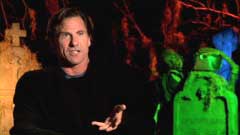
The way in which the individual interviews are so fragmented throughout the length of the program in service of the conception/pre-production/shooting/post-production/response structure makes for a somewhat frustrating view, as the contributions of some of the participants seem less specific than others. While there is a lot of a minutia covered, some aspects are given short shrift. Stacey Q of the band SSQ shows up long enough to mention that Enimga Records approached them about using “Tonight” in the film (Quigley danced to Vanity’s “Nasty Girl” on set), but there little information given about who was responsible for the choice of songs for the memorable compilation soundtrack. Similarly, Matt Clifford’s and Francis Haines’ memorable Trioxin theme – or their collaboration on the score with SSQ – is not addressed at all (it is not excerpted anywhere in the documentary, which has its own theme music by Lito Velasco and Sean Schafer Hennessy [both of whom provided music for the “Elm Street” documentary NEVER SLEEP AGAIN]). In the final memoriam section to O’Bannon (although the end credits dedicate the documentary to eight more ROTLD cast and crew who have passed on, including Venturini and Tom Fox), Henderson laments that O’Bannon was not around to realize how well-liked his film was (evidently over-looking the fact that O’Bannon had recorded an audio commentary for the MGM DVD release a few years before his death). O’Bannon himself is only featured very briefly in archival footage (the longer interview is available in the supplements, but everyone speaks of him in the feature in the past tense and the audio and video quality of the interview is of much lesser quality than the newer ones).
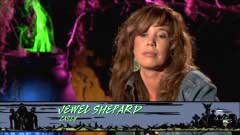 Space-wise,
Michael Perez Entertainment’s dual-layer DVD is packed. Besides the two
hour documentary feature, there is just under another two hours of extras. This
may compromise the overall image quality of the documentary and all of the featurettes,
but we’re talking about a documentary here. The whole thing is a mix of
HD video talking head interviews, graphics, analogue video sources of varying
age and quality, and film clips of varying quality. The only people that would
be more concerned about the image quality of the documentary – over the
information that it imparts – are likely the people who put it together.
The audio is Dolby Digital 2.0 stereo, which makes sense given the emphasis
in the feature documentary on talk and the film clips are in mono as they were
originally mixed. English SDH subtitles have been included for the feature only.
Space-wise,
Michael Perez Entertainment’s dual-layer DVD is packed. Besides the two
hour documentary feature, there is just under another two hours of extras. This
may compromise the overall image quality of the documentary and all of the featurettes,
but we’re talking about a documentary here. The whole thing is a mix of
HD video talking head interviews, graphics, analogue video sources of varying
age and quality, and film clips of varying quality. The only people that would
be more concerned about the image quality of the documentary – over the
information that it imparts – are likely the people who put it together.
The audio is Dolby Digital 2.0 stereo, which makes sense given the emphasis
in the feature documentary on talk and the film clips are in mono as they were
originally mixed. English SDH subtitles have been included for the feature only.
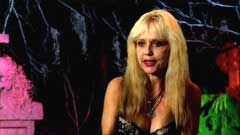
“They Won’t Stay Dead: A Look at RETURN OF THE LIVING DEAD Part II” (29:42) details Tom Fox’s troubled cash-in sequel. Henderson bowed out of the production, while Stout was vehemently against it and threatened to sue them if they used his designs. Effects man Myers handled the zombie effects and brought in actor Peck (who narrates again) as one of the principal zombie actors to don multiple masks and appliances. Myers is less satisfied with his work on the sequel – despite having more time – especially the new Tarman design (actor Trautman is also less enthused about his own performance). Also interviewed are actor Michael Kenworthy (THE BLOB) – who played the film’s child lead – and actress Suzanne Snyder (KILLER KLOWNS FROM OUTER SPACE). Snyder was a friend of Mathews, who rehearsed with her before the audition to help her nail the part. Mathews and Karen air on the side of “if you can’t say anything nice…” but Kenworthy and Snyder have fond memories of the experience. Sammon did marketing on the sequel and found that the distributors wanted him to place emphasis on overseas publicity because of the first film’s success in Japan. A few of the interviewed cast and crew suggest that Weiderhorn did not have an affinity for the horror genre, despite the fact that he directed EYES OF A STRANGER and SHOCK WAVES; although, perhaps he felt that he already done zombies, and done them well (producer Fox had enough faith in Weiderhorn to bring him onto the troubled DARK TOWER to replace Freddie Francis, although that film was no triumph). Apparently, the documentary producers were not able to license clips from the film, which is visually represented here solely through production stills.
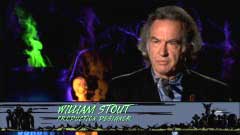 “Love
Beyond the Grave: A Look at RETURN OF THE LIVING DEAD 3” (20:52) describes
the second sequel’s attempt to take things in a new direction. Henderson
once again declined, and Peck’s idea for a sequel was one of nearly a
dozen that were rejected. John Kenney (second assistant editor on ROTLD) wrote
the final script, and was instrumental in bringing in Brian Peck for a brief
role as a ballistics expert in one of the film’s gory highlights. Brian
Yuzna and Penney describe the self-mutilation aspect of the film’s tragic
heroine. Of the cast, only male lead J. Trevor Edmond (PUMPKINHEAD II) is interviewed
(actress Mindy Clarke is present on an audio commentary for ROTLD 3 on the Trimark
disc, however). Effects man Steve Johnson (who was married Linnea Quigley) discusses
Yuzna’s decision to farm the various effects set-pieces out to different
effects houses in the interests of time and money. As with the ROTLD II featurette,
there are no film clips here from part 3; however, there is enough behind the
scenes video footage on hand here to illustrate the points made by the participants.
Regardless of how terrible they are, I would imagine that parts 4 and 5 were
not covered by this set for two reasons: 1) they were shot in Romania with only
a handful of American (i.e. affordably accessible) cast and crew members, and
2) these more recent sequels have behind the scenes material on their respective
DVD releases (although these likely lack critical distance).
“Love
Beyond the Grave: A Look at RETURN OF THE LIVING DEAD 3” (20:52) describes
the second sequel’s attempt to take things in a new direction. Henderson
once again declined, and Peck’s idea for a sequel was one of nearly a
dozen that were rejected. John Kenney (second assistant editor on ROTLD) wrote
the final script, and was instrumental in bringing in Brian Peck for a brief
role as a ballistics expert in one of the film’s gory highlights. Brian
Yuzna and Penney describe the self-mutilation aspect of the film’s tragic
heroine. Of the cast, only male lead J. Trevor Edmond (PUMPKINHEAD II) is interviewed
(actress Mindy Clarke is present on an audio commentary for ROTLD 3 on the Trimark
disc, however). Effects man Steve Johnson (who was married Linnea Quigley) discusses
Yuzna’s decision to farm the various effects set-pieces out to different
effects houses in the interests of time and money. As with the ROTLD II featurette,
there are no film clips here from part 3; however, there is enough behind the
scenes video footage on hand here to illustrate the points made by the participants.
Regardless of how terrible they are, I would imagine that parts 4 and 5 were
not covered by this set for two reasons: 1) they were shot in Romania with only
a handful of American (i.e. affordably accessible) cast and crew members, and
2) these more recent sequels have behind the scenes material on their respective
DVD releases (although these likely lack critical distance).
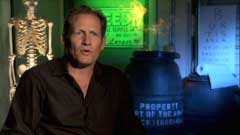
“A Conversation with Dan O’Bannon: The Final Interview” (28:29) is not restricted to RETURN OF THE LIVING DEAD. He starts off talking about his experience on THE RESURRECTED – his direct-to-video adaptation of H.P. Lovecraft’s “The Case of Charles Dexter Ward” – and how it was completely restructured by the distributors without his involvement out of outtakes. O’Bannon also gives us a bit more on the legal issues with Romero and Russo, and earnestly describes how and why he wanted to distinguish his film from a Romero-clone. He speaks well of the cast and how he would like to use them again if he directed again. He also recalls the issue with Quigley’s “codpiece” for the nude scene, and is forthcoming about his “bad management” of some of the actors and his unintentional insensitivity towards them (he specifically cites Randolph and Gulager), including the influence of schooling at USC (which leaned towards the auteur theory). He does regret intentionally making the actors uncomfortable to get a reaction out of them (and humorously recalls fearing that Gulager would really come after him with the lead pipe his character was carrying around). He is less kind when discussing director of photography Jules Brenner. He goes into more depth about the scoring – leaning heavily on the music editor to make the hours of un-synched score cues “work” – and selecting the various punk songs for the film (once again, leaning heavily on the music supervisor). The documentary closes on a bittersweet note with moving response to the “if this were your last interview” question.
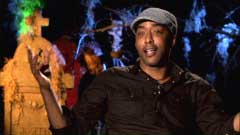 Fourteen
deleted scenes (totaling roughly 16 minutes) from the documentary are also included.
In “There’s Something about Beverly” (2:39), actress Randolph,
effects artist William Munns, and co-producer Henderson recall the waste of
time and effort that went into making appliances to make the actress’
teeth look perfectly straight. In “Linnea’s Hair” (0:41),
Quigley recalls requesting a wig since her real hair would retain the look and
color of her character’s punk hairdo in the rain. In “Researching
the Dead” (2:39), production designer Stout recounts some grisly anecdotes
from his visits with Dan O’Bannon to various crematoriums, cemeteries,
and mortuaries while researching the film. In “Locations” (0:35),
Henderson and Randolph briefly describe the comfort and practicality of the
mostly self-contained location for the film. In “William Stout’s
Cameo” (0:32), Stout points out his cameo as a wino in the beginning of
the film and says that he stayed in character throughout the day to mess with
the cast and crew. “Miguel’s Hidden Secret” (0:41) is a back-and-forth
piece between talking heads of Nunez and Quigley where they discuss their appreciation
of each others “assets.” More amusing is “Choking a Chicken”
(1:10) in which actors Philbin, Shepard, and Randolph and co-producer Henderson
recall Shepard’s difficultly with the line “Go choke a chicken”
because she did not know what it meant (O’Bannon reportedly had her do
forty-four takes of the line). In “Pocket Watch” (1:46), Peck relates
that Spider’s scene with the pocket watch was originally written for him,
and that O’Bannon placated him by quickly scripting a little monologue
for him (which was never shot). In “The Coroner’s Corpse”
(1:05), actor Calfa and effects artist Myers describe how careful they had to
be using real mortuary equipment on an actor fitted with make-up appliances.
In “Jules Brenner’s Secret Identity” (1:05), actor Deighan
recalls that DP Brenner uses a fake name on the call sheets because it was a
non-union production. In “Thom’s Injury” (0:43), Mathews and
Randolph recall the head injury he received bursting through the attic door
in the final scene (which probably explains why the shot freeze frames so quickly
in the finished cut of the film). In “Editing the Film” (1:24),
second assistant editor John Penney recalls having nothing to do but watch the
shooting and sip cocktails when he should have been synching dailies because
O’Bannon wanted to be very hands-on in the editing. In “Remembering
Dan O’Bannon” (0:29), actor Gulager shows us his program from O’Bannon’s
memorial service. Finally in “Parting Words” (1:01), Deighan, Dalesandro,
Stacey Q, and James Karen briefly sum up their experiences on the film. These
little bits are nice, but they were wisely deleted from the already two-hour
feature for timing as well as the flow of topics.
Fourteen
deleted scenes (totaling roughly 16 minutes) from the documentary are also included.
In “There’s Something about Beverly” (2:39), actress Randolph,
effects artist William Munns, and co-producer Henderson recall the waste of
time and effort that went into making appliances to make the actress’
teeth look perfectly straight. In “Linnea’s Hair” (0:41),
Quigley recalls requesting a wig since her real hair would retain the look and
color of her character’s punk hairdo in the rain. In “Researching
the Dead” (2:39), production designer Stout recounts some grisly anecdotes
from his visits with Dan O’Bannon to various crematoriums, cemeteries,
and mortuaries while researching the film. In “Locations” (0:35),
Henderson and Randolph briefly describe the comfort and practicality of the
mostly self-contained location for the film. In “William Stout’s
Cameo” (0:32), Stout points out his cameo as a wino in the beginning of
the film and says that he stayed in character throughout the day to mess with
the cast and crew. “Miguel’s Hidden Secret” (0:41) is a back-and-forth
piece between talking heads of Nunez and Quigley where they discuss their appreciation
of each others “assets.” More amusing is “Choking a Chicken”
(1:10) in which actors Philbin, Shepard, and Randolph and co-producer Henderson
recall Shepard’s difficultly with the line “Go choke a chicken”
because she did not know what it meant (O’Bannon reportedly had her do
forty-four takes of the line). In “Pocket Watch” (1:46), Peck relates
that Spider’s scene with the pocket watch was originally written for him,
and that O’Bannon placated him by quickly scripting a little monologue
for him (which was never shot). In “The Coroner’s Corpse”
(1:05), actor Calfa and effects artist Myers describe how careful they had to
be using real mortuary equipment on an actor fitted with make-up appliances.
In “Jules Brenner’s Secret Identity” (1:05), actor Deighan
recalls that DP Brenner uses a fake name on the call sheets because it was a
non-union production. In “Thom’s Injury” (0:43), Mathews and
Randolph recall the head injury he received bursting through the attic door
in the final scene (which probably explains why the shot freeze frames so quickly
in the finished cut of the film). In “Editing the Film” (1:24),
second assistant editor John Penney recalls having nothing to do but watch the
shooting and sip cocktails when he should have been synching dailies because
O’Bannon wanted to be very hands-on in the editing. In “Remembering
Dan O’Bannon” (0:29), actor Gulager shows us his program from O’Bannon’s
memorial service. Finally in “Parting Words” (1:01), Deighan, Dalesandro,
Stacey Q, and James Karen briefly sum up their experiences on the film. These
little bits are nice, but they were wisely deleted from the already two-hour
feature for timing as well as the flow of topics.
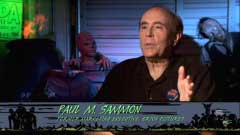 “Stacy
Q Live ‘Tonight’ Music Video” (3:31) features a recent performance
of SSQ’s theme song “Tonight (We’ll Make Love ‘til We
Die).” In “Resurrecting Settings: The Film Locations Today”
(10:00), Beverly Randolph and Brian Peck take us through the locations as they
are today. The exterior of the medical supply center has been renovated and
it is now a private residence. They also visit Kenny Myers’ home/workshop
where some of the zombie moulds and props are still around, as well as the warehouse
in which the interior sets were all built (it also house the production offices,
art department, dressing rooms, and editing facilities). The last location is
the olive grove where the cemetery set and mortuary exterior were built (which
is now a quaint housing suburb). Lastly, “Return of the Living Dead in
3 Minutes” (3:00) summarizes the film in three minutes entirely through
delivery of the film’s highly quotable dialogue by several of the actors.
Trailers for MORE BRAINS (1:35) and NEVER SLEEP AGAIN: THE ELM STREET LEGACY
(0:57) – which is hopefully as thorough – round out the package.
(Eric
Cotenas)
“Stacy
Q Live ‘Tonight’ Music Video” (3:31) features a recent performance
of SSQ’s theme song “Tonight (We’ll Make Love ‘til We
Die).” In “Resurrecting Settings: The Film Locations Today”
(10:00), Beverly Randolph and Brian Peck take us through the locations as they
are today. The exterior of the medical supply center has been renovated and
it is now a private residence. They also visit Kenny Myers’ home/workshop
where some of the zombie moulds and props are still around, as well as the warehouse
in which the interior sets were all built (it also house the production offices,
art department, dressing rooms, and editing facilities). The last location is
the olive grove where the cemetery set and mortuary exterior were built (which
is now a quaint housing suburb). Lastly, “Return of the Living Dead in
3 Minutes” (3:00) summarizes the film in three minutes entirely through
delivery of the film’s highly quotable dialogue by several of the actors.
Trailers for MORE BRAINS (1:35) and NEVER SLEEP AGAIN: THE ELM STREET LEGACY
(0:57) – which is hopefully as thorough – round out the package.
(Eric
Cotenas)